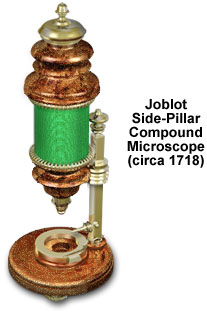Joblot Side-Pillar Compound Microscope
French mathematics professor and bacteriologist, Louis Joblot created his side-pillar compound microscope in the style promoted by British innovators Robert Hooke and John Marshall. A combination of brass, turned wood, glass, cardboard, and paper were employed to fabricate the elegant instrument.

Constructed in 1718, the Joblot side-pillar compound microscope utilizes stops or diaphragms to help correct chromatic aberrations and includes a brass lens cap, which may be placed so that the eyepiece is protected when not in use. The optical system of the instrument includes an ocular, an objective at the other end of the body tube, and an internal field lens. Similar to contemporary Dutch models mounted on three feet, the Joblot microscope is equipped with a substage tube for transmitting light. Other features of the instrument include a pin attached to the rectangular pillar that may be used to hold the specimen, and a brass well, which is utilized to contain aquatic specimens or chemical solutions.
Employed at the École Nationale des Beaux-Arts, Joblot became interested in microscopy in 1678 when Dutch scientists Christiaan Huygens and Nicolas Hartsoeker came to Paris and demonstrated their microscopes. In fact, Joblot is considered the first serious French microscopist, though he is more famous as a pioneer in bacteriology. Publications of his illustrated microscopic observations of insects, fungi, and protozoa helped spur interest in microscopy and microbiology across Europe.
BACK TO EIGHTEENTH CENTURY MICROSCOPES
